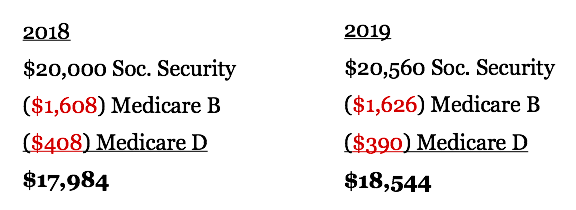Pay Raise
It has been years since retirees have seen a meaningful cost of living adjustment (COLA) to their Social Security retirement benefit. The two-pronged impact of minimal COLAs coupled with substantial Medicare premium increases has flattened the amount of this important source of retirement income. 2019 will offer a small break to this pattern. Social Security announced a 2.8% increase to 2019 retirement benefits. Medicare B premiums will increase by 1.1%. Part D premiums will slightly decline.
For example, a retiree with an annual 2018 retirement benefit of $20,000 will see an annual increase of $560. This assumes a national average for Part D costs. Keep in mind, retirees with higher incomes (MAGI exceeding $85,000 single or $170,000 joint) have higher Medicare B and D premiums.

While mapping out phone calls to retirees to deliver this bit of good news, make sure to schedule conversations with pre-retirees on strategies to build tax-free retirement income. As discussed in prior newsletters, building tax-free retirement income is critical to reducing Medicare expenditures.
Health Savings Accounts, with pre-tax contributions, tax-free growth and tax-free health expenditure distributions offer one ideal solution. 2019 Health Savings Account (HSA) contribution limits will increase to $7,000 for family coverage and $3,500 for single coverage. The age 55 catch up remains at $1,000. Remember to keep some of a married couple’s HSA investment in each spouse’s name enabling each spouse to contribute the $1,000 age 55 catch up. Remember, health care costs will be greatest for most individuals in retirement. HSA’s offer a tremendous way to accumulate assets for retirement health care costs.
A married couple who fully funds and invests their HSA starting at age 50 could accumulate $370,000 for retirement. This assumes an 8% return over this 17 year stretch and a 2% increase to the base contribution limit.
- For a more detailed look into this strategy, including ways for spouses and children to distribute this account income tax free, listen to my HSA C/E webinar (CFP® C/E)
- To learn about offering an HSA through your RIA or broker dealer send me an email: pfstahl@bedrockresults.com
The Roth IRA and Roth 401(k) continue to provide a premier means to build tax-free retirement income. The 2019 Roth IRA contribution limit increases to $6,000 with a $1,000 age 50+ catch up. 2019 income limits allowing the Roth IRA are also up. 2019 Roth 401(k) contribution limits increase to $19,000 with a $6,000 age 50+ catch up provision.
As clients make elections for 2019 employee benefits, now is the time to change those employee deferrals from the traditional 401(k) to the Roth 401(k). Do your clients even know if this is a choice their employer provides? A fully funded Roth 401(k) from age 55 to age 67 would grow to over $1 million dollars (assumes an 8% return and a 2% annual increase to the base contribution limit).
Non-qualified investment accounts and traditional pre-tax defined contribution plans have the potential to drive retirees into higher Medicare premiums and hence lower Social Security Benefits. Compliment these investment strategies with tax-free and tax-deferred investment programs
Peter Stahl www.bedrockresults.compfstahl@bedrockresults.comThe information in this presentation is provided as a general overview. It is derived from the Internal Revenue Code, Medicare.gov and other government publications, all subject matter sources reasonably believed to be reliable. Tax law and the laws governing Medicare/Medicaid are complex and subject to change. Clients should consult with their attorney and/or qualified tax advisor when making decisions regarding these matters.